Art of the Renaissance 3
1/43
There's no tags or description
Looks like no tags are added yet.
Name | Mastery | Learn | Test | Matching | Spaced |
|---|
No study sessions yet.
44 Terms
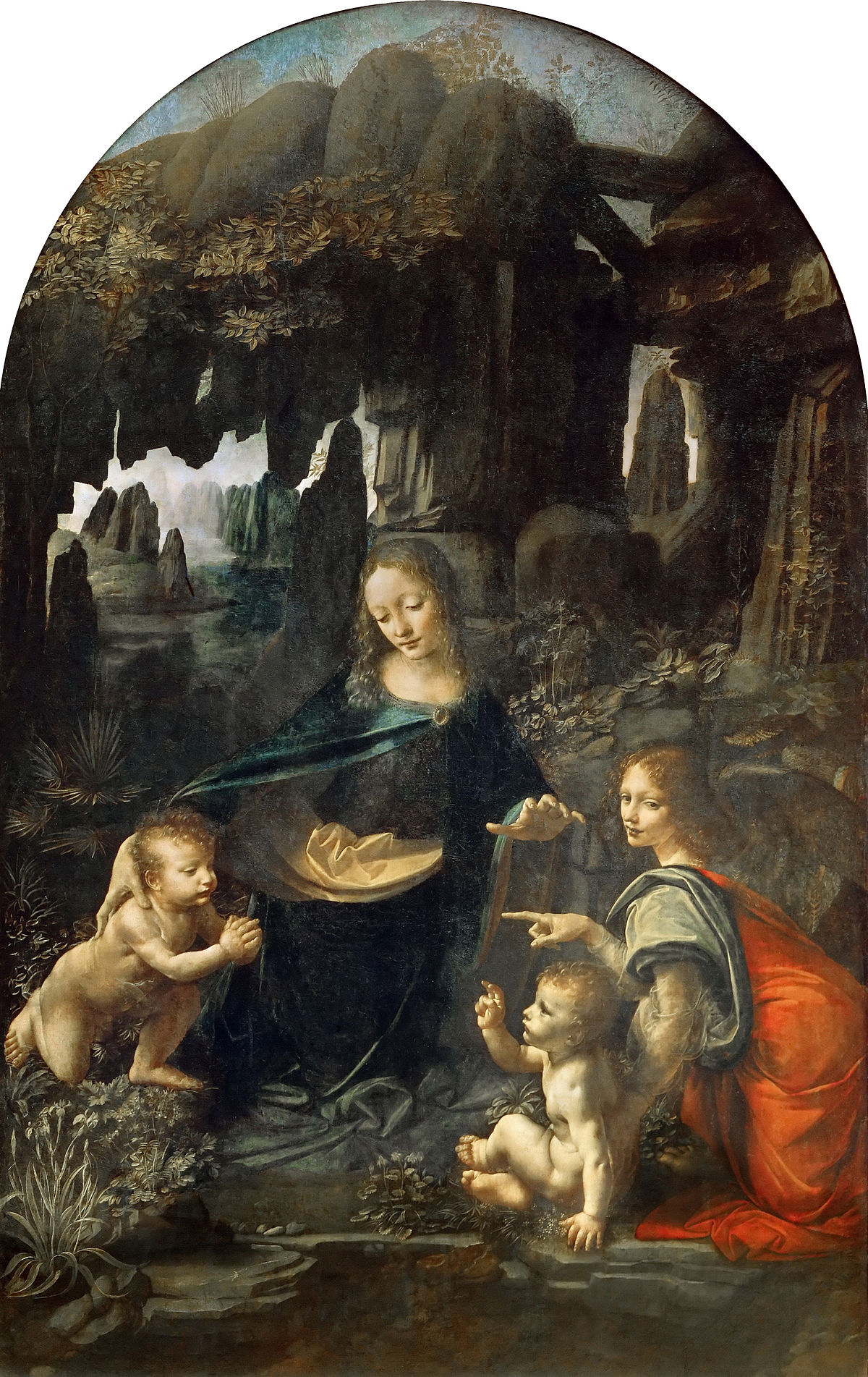
Leonardo da Vinci, Virgin of the Rocks, San Francesco Grande, Milan,(1480)
Commission: Confraternity of the Immaculate Conception (group that focused on the public veneration of the Blessed Virgin Mary), patron was Ludovico Sforza (Duke of Milan)
Subject: oil on panel, very untraditional rendering of Mary with Christ, angel, and John the Baptist
Form: ordering system is not hierarchical, normally elevated but on the ground here, makes natural arch w/ nature to display divineness, leaves to represent cloths of honor, not posed, in active motion, calm representation, warm colors, geometric arrangement, separated but united through gestures, rocky space meant to separate us from them, dark and gloomy, rich and saturated colors, softness of edges, dark areas against the light (Chiaroscuro), smoke like images (Sfumato), pronounced gestures - point of high renaissance
Function: show a natural representation of Mary with Christ interacting with John the Baptist as children, connects them with nature, can use nature to display classical ideas

Leonardo da Vinci, Last Supper, Santa Maria della Grazie, Milan, (1500)
Commission: For the Church’s refractory, patron was Ludovico Sforza
Subject: fresco plan, oil and tempera, shows the Last Supper scene in the Bible where Jesus reveals to the disciples that someone will betray Him
Form: Duke and sons are referenced with coat of arms, high on wall, one point linear but not for the whole room, looking up at Christ, no halos, Christ has triangular form - shows stability, trinity - Judas is not on other side of table (holding a sack of money and leaning away from Christ), groups of three (all different reactions, intertwined), dramatic gestures ties everything together, diagonals lead us to Christ, developed extensive landscape behind Christ (blue air), wall hangings but are actually doorways, natural halo by light from window, coffers, grid system on floor
Function: Goes away from traditional view of the Last Supper but makes it a more realistic display yet separates us from the divineness of the scene

Leonardo da Vinci, Madonna and Child with St. Anne, (1500)
Commission: patronage is unknown, personal painting
Subject: Mary, Jesus, and Mary’s mother St. Anne all sitting together in a familial stance
Form: intertwined figures, implied triangle (living, moving), mysterious natural setting, rocky gap that separates us from them, trees and extensive rocky bakcground, bright colors of robes, sense of love and family, using both techniques of blending soft shadows and light and dark to help depth, lamb with Christ, Mary is pulling Christ away from lamb b/c He is not being delicate, grinning like a child, very human behavior, very natural, no pomegranate
Function: symbolic since lamb is sacrifice and Christ is accepting the lamb but Mary is trying to pull Him away b/c she doesn’t want Him to die, wants to show a natural representation of the holy family and how they can interact with each other in a natural way.
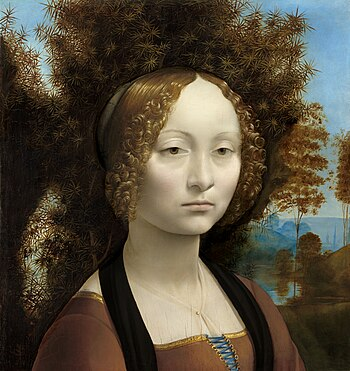
Leonardo da Vinci, Ginerva de’ Benci, (1480)
Commission: Venetian ambassador who marries Ginerva de’ Benci, daughter of Florentine banker
Subject: Ginerva de’ Benci’s portrait, celebration of her wedding
Form: emblem on back that speaks to her virtues, palm, laurel, purity, chastity, juniper, hairstyle is popular in time, setting helps her face to stand out, not in profile, turning towards viewer, not confrontational so she doesn’t met our eyes, water, blue air and orange/brown leaves, cut off her hands from the portrait, triangle when all parts are together which shows stability and confidence, hands reveal that she might have been holding something
Function: Wants to break from traditional portrait style of the time and try out different tactics to reveal parts of her character

Leonardo da Vinci, Lady with an Ermine (Portrait of Cecilia Gallerani), (1480)
Commission: Duke of Milan, oil on panel, Cecilia Gallerani, member of the court, and a favorite of the duke
Subject: Cecilia Gallerani’s portrait
Form: uses chiaroscuro, hand is detailed and draws attention to ermine (mink, fur was very valuable), distracted by something, life in eyes-individuality, traditional clothes, deep reds, blues, yellows, ermine refers to sitter, galee- similar to root of surname (punny), other associations: complimenting her with the white fur meant as purity, symbol of Duke, sports of heraldry, uses nature as a symbol speaking to other qualities complimenting the sitter, lots of patterns in black, texture in folds of clothes, youth and beauty, bright white skin
Function: speaks to relationship between duke and sitter, shows Leonardo wants to have more fun and experiment with human emotion in his paintings.
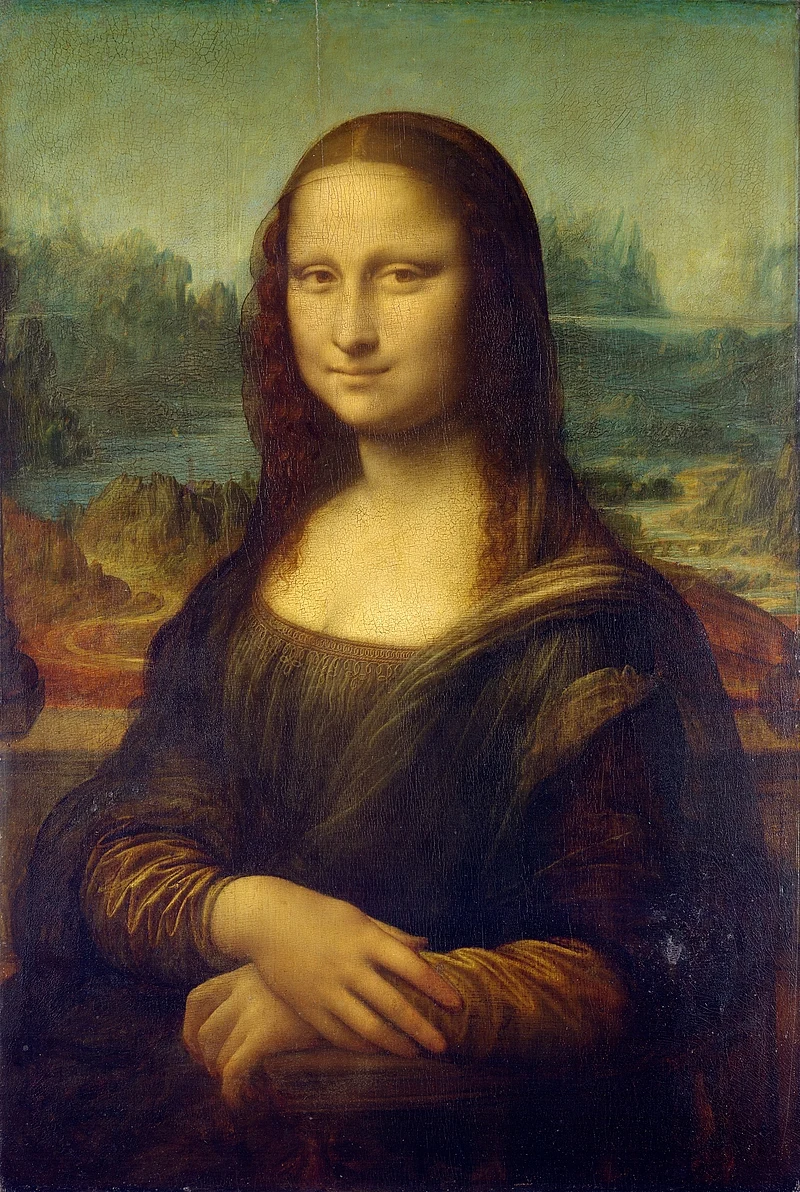
Leonardo da Vinci, Mona Lisa, (1500)
Commission: Florentine Banker Giocondo wanted Leonardo to paint his wife/fiancée, oil on panel, 2 ft by 1 ½ ft
Subject: Lisa,, his significant other, Mona - term of respect
Form: mysterious landscape, based on observations, intriguing smile, engaging with viewer, outside of expectations of female behavior of wealthy, demo piece for his capabilities, ¾ view, sense of composure and stability, triangular presnce, looks confident, eyes are little shifted, sense of character, dark clothing causes brightness of skin to show, personality, being entertained, didn’t want melancholy, wooden stare, lot of complexity in background, draws connection between nature and sitter, parts of her go into background which develops oneness, originally framed by columns, classical imagery, sfumato
Function: takes portraiture further, causes questioning for viewer, wedding creation, wants to give more life to his portraits to make them more human
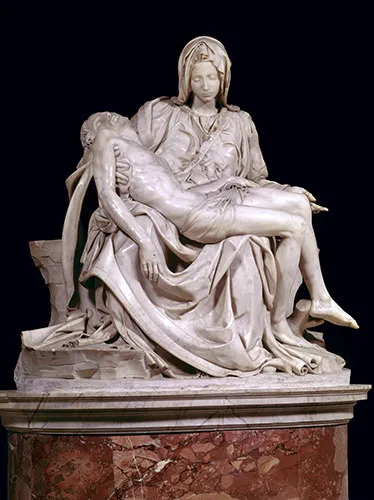
Michelangelo, Pieta (1500)
Commission: French Cardinal in Rome, main monument in burial chapter in old St. Peter’s Church, Lorenzo the Magnificent chose Michelangelo to be trained, white marble, chose his own block
Subject: Pieta: pity, image of Mary grieving the loss of her son, subject is unusual for central Italy, maybe due to French Patron, normally displayed in wood and in crucifixion
Form: supposed to be directly on floor so people could contemplate and look at Christ and Mary’s face, hands invites us in, Mary sits on simple rock, offering Him up, stoic, saddened, contained grief with acceptance, Christ - anatomically accurate, look at His face instead of His limbs, triangular forms and alters scale of Mary, more balanced composition, pleasing if Mary is bigger than Christ
Function: embraces belief that Christ is her son, reminiscent of infancy portraits, asserts inner beauty instead of directly saying it, Mary is portrayed as very young to show innocence and purity
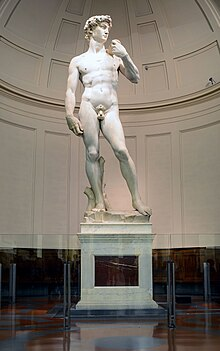
Michelangelo, David (1500)
Commission: Florence Cathedral, but later moved to townhall (Medici’s have been expelled from Florence so the Wool Merchants Guild has taken over this niche)
Subject: 17 ft tall, marble sculpture carved from pre-existed block, adult form of David before his fight with Goliath
Form: adult ideal male form, more developed, true understanding of anatomy, no mention of Goliath, moment he arrives to the place to prepare for his fight with Goliath, sling is there, but secondary, emphasis is on body and face, first look is repose, contrapposto, and potential to act, second look is concerned, furrowed brow, alert eyes, tense veins popping, fidgety hands
Function: David is the new symbol of the renewed republic, Florence used to have Hercules be there seal and figure, but now kind of model David after Hercules, they are Christianizing Hercules’ story of pursuing virtue
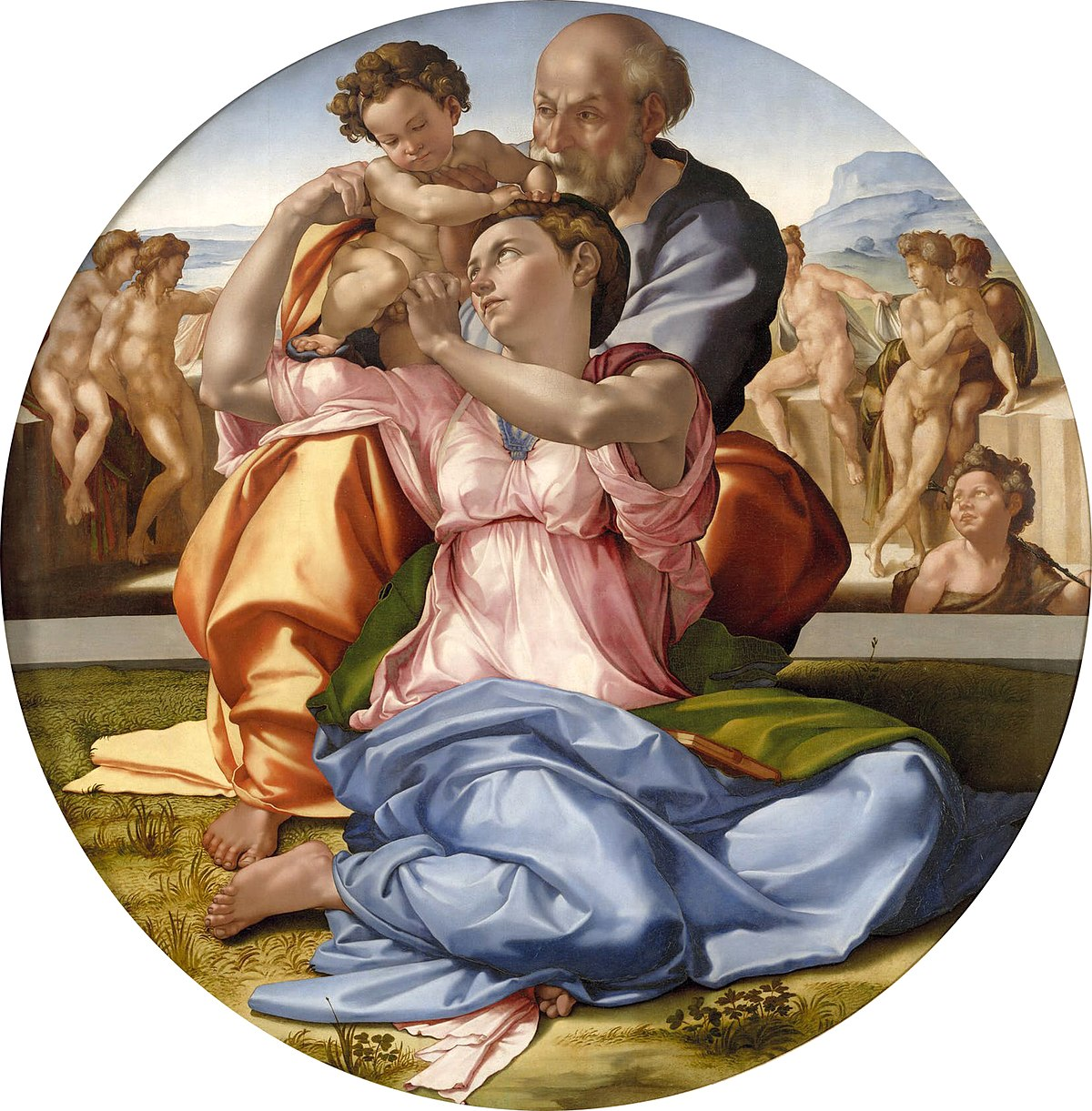
Michelangelo, The Holy Family (Doni Tondo), (1510)
Commission: gift for a wedding, patron was Angela Doni and husband Strozzi, wealthy banking families
Subject: oil and tempera on panel, the Holy family spending time together with John the Baptist looking at them and classical figures standing in the background
Form: John the Baptist in image - camel, reed staff, tussled hair (acts as a bridge between pagan past and Christian present), figures are not paying attention/engaging with Holy Family, Mary is in traditional colors (blues, reds/pinks), triangular form, heavy base, active/moving motions, Mary on the ground, humble, complex pose, Joseph is handing Christ to Mary who has to lean back, figures in the back show his love for sculpture, pronounced contour, the lines involved, almost like marble w/ how bright the light is, depression in the earth takes on the image of a half moon, motif from the Strozzi coat of arms, not very developed landscape
Function: figures represent the pagan world and how they are ignorant to Christian doctrine and the physical space that divides them, is a showpiece for his skill of being able to draw complex images and complex figures

Michelangelo, Sistine Chapel Ceiling, Vatican (1510)
Commission: Pope Julius II wanted Michelangelo to paint his private chapel, the Sistine Chapel (first Papal commission)
Subject: fresco, stories and figures from Old Testament and Genesis for the main portion of the ceiling, acorns in image draw connection to Julius’ coat of arms
Form: sculptural figures, bright colors, hard quality, living and moving figures get more monumental, paints sculpture and bronze medallions, nudes, The Flood/Deluque: fear emphasis, focuses on the human part of the story rather than landscape, range of emotions, very complex poses with twisting and intertwining (theme for whole ceiling), Temptation and the Fall: conflated narrative, powerful figures before fall and very defeated afterward, become dark, sad, not youthful, aged, pronounced gestures, Creation of Adam: gesture!!, heavily muscled but weak - needs touch of God, grouping of figures that support God look like a brain (gives us the ability to think), Mary and Jesus present
Function: Renaissance interest in order, uses architecture to bring in figures, shows the stories and people that prefigure Christ, showcases his ability to manipulate paint, shows knowledge of ancient stories and images, appreciate the human form
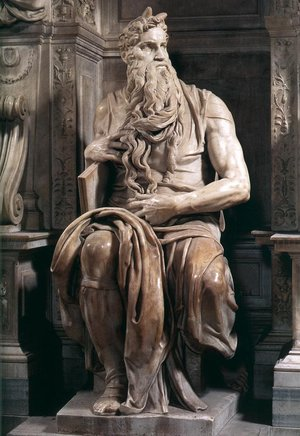
Michelangelo, Moses, (1510)
Commission: Pope Julius' II, wanted this piece to not be stand alone, but a part of his tomb setting (combo of architecture and sculpture)
Subject: Moses after he has received the 10 commandments and has come down from the mountain, 7 ½ feet tall, part of a 2 story structure
Form: monumental presence, reminiscent of Sistine Chapel figures, sleeveless shirt, shows his muscles, Michelangelo and Pope Julius’ presences are felt in image, terribilita - induced by a sense of terror/awe, agitated expression, trembling indignation, hand is adjusting, shows his anger, veins popping, beard is curly, furrowed brow, extreme eyes, veracity, growing anger, horns are on top of head b/c of a mistranslation by St. Jerome
Function: shows the story of Moses where he realized what was happening when the Hebrews went against God and started to worship the golden calf, shows his anger and how he is trying to control it but you can see the anger building within him
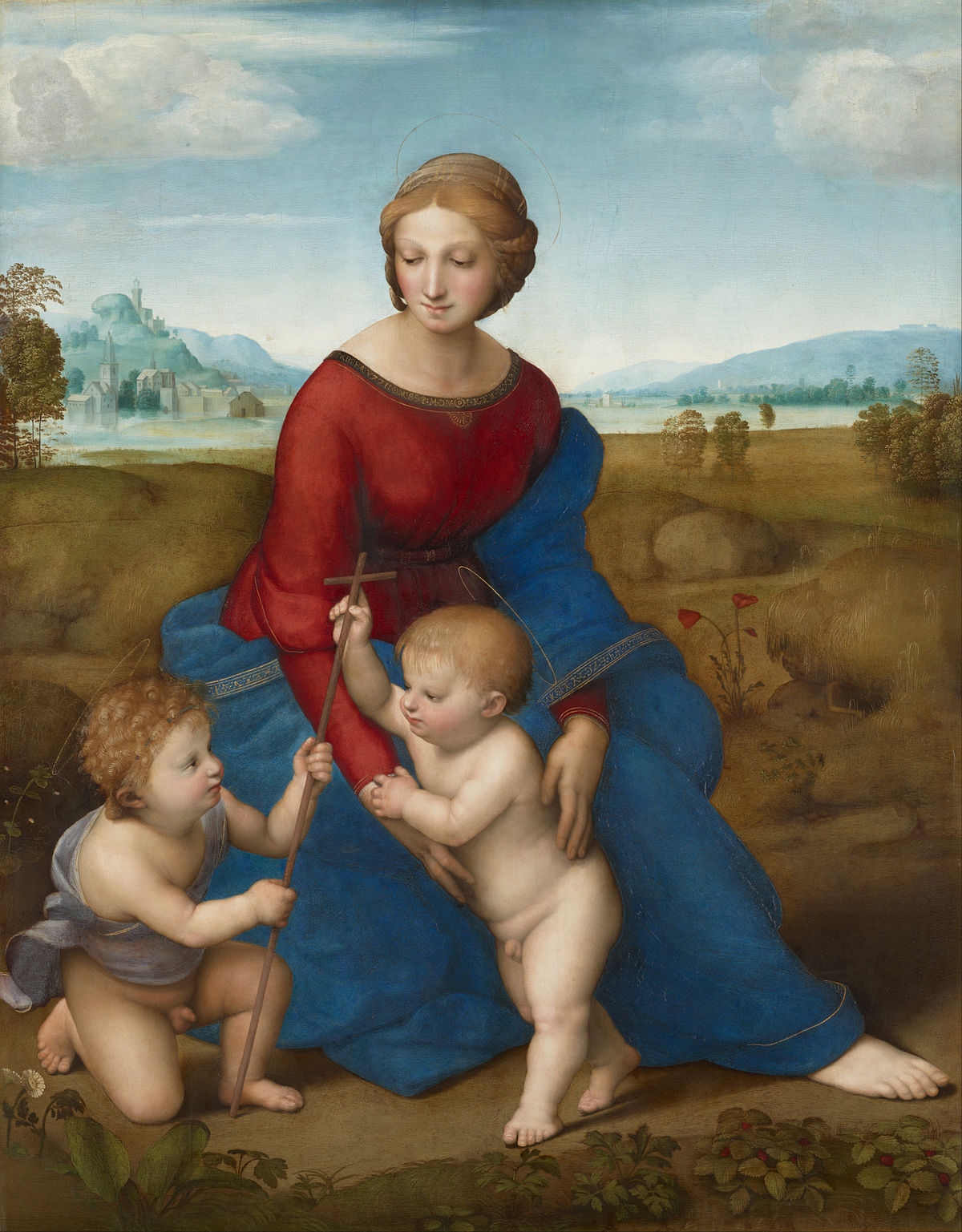
Raphael, Madonna of the Meadow (1510),
Commission: Taddeo Taddei, Vienna
Subject: John the Baptist, Jesus and Mary are sitting together in a bright landscape
Form: old fashioned halos - golden details, richness of reds and blues, all sweet and blonde, not mysterious landscape, triangular form, movement through gazes, very human manners, figures are front centered, simple town in background, blue air horizon, brightness, evenly illuminated, not very complex movements
Function: show the human connection that Mary has with Jesus and John the Baptist, humbles them and puts them into a human situation that is calm and relaxed
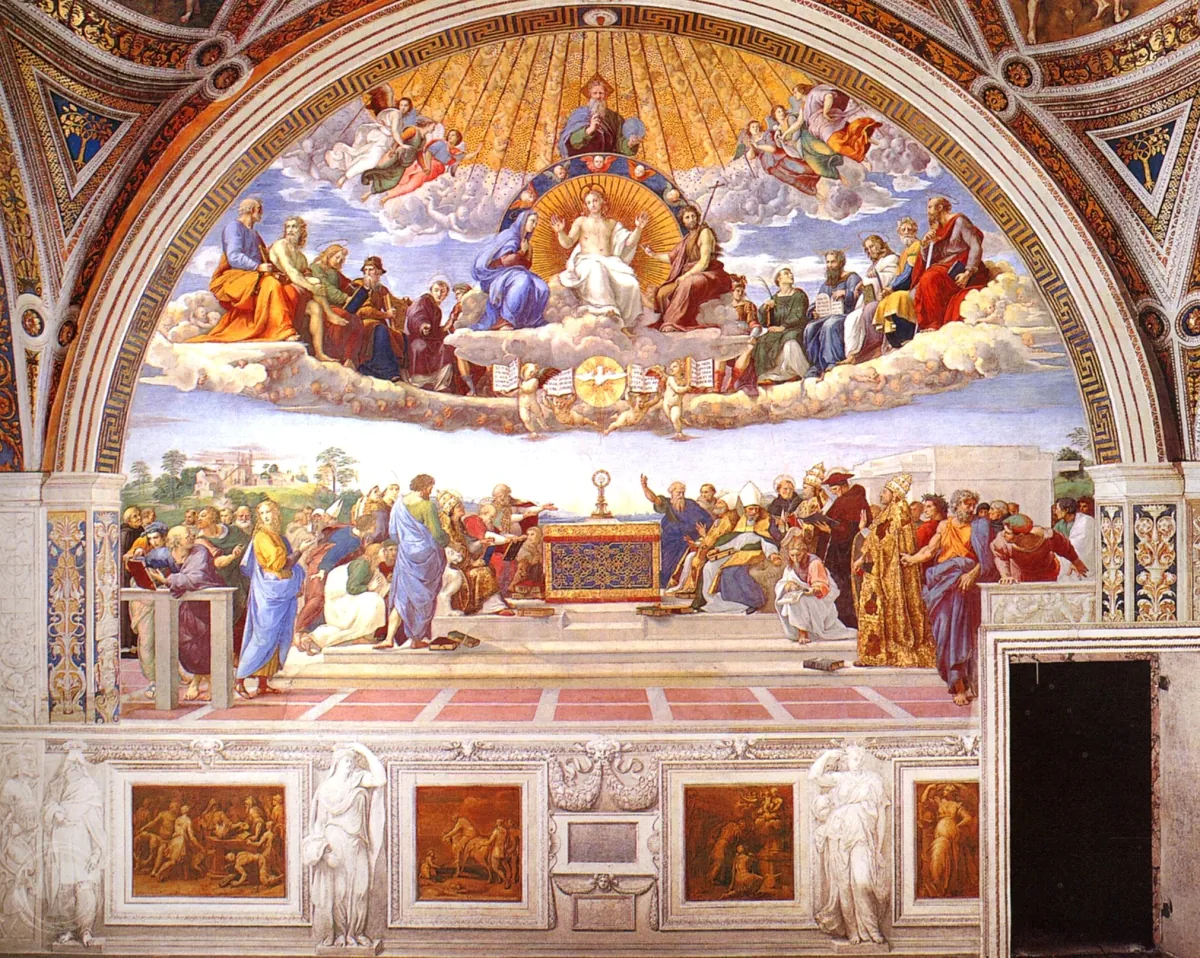
Raphael, Disputa, Stanza della Segnatura, Vatican, (1510),
Commission: Pope Julius II, papal apartments of the Stanza della Segnatura in the Vatican (Rome)
Subject: fresco, hierarchy (Trinity), Mary, John the Baptist, and other important church saints and figures are all discussing something and trying to go to the texts to determine a decision
Form: extension of room into nature, Theology, inventive subject, addresses aspect of Christian debate, active figures, discussion over church doctrine - specifically transubstantiation, distinct realms (heavenly and earthly), important people arguing, architectural framework, Greek patterns, monstrance holds Christ who has stigmata, gestures!, architecture is not making it circular, the people are, arches, layers, semi circular, golden stars and rays, angels, balance and order, texts in heaven and earthly realm, beautiful colors, figures in clouds, seems chaotic by organized, 4 fathers of church are closest to altar but St. Gregory is meant to resemble features of Pope Julius II
Function: show Pope scenes that would remind him of his duties since the room was used as a place where the Pope would sign important documents for judgment by the Tribunal in Rome, learning is very valuable and used, empirical and wanting fact
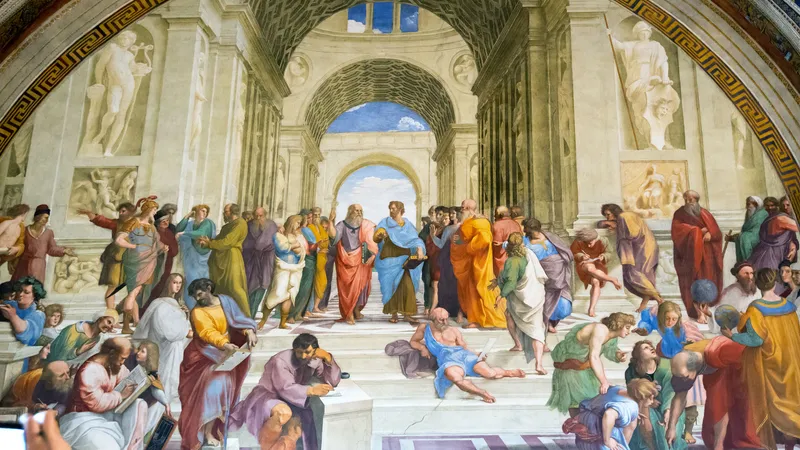
Raphael, School of Athens, Stanza della Segnatura, Vatican, (1510),
Commission: Pope Julius II, Pope’s apartments
Subject: fresco, major philosophical figures (contemporary and past) are all speaking to each other and learning/teaching
Form: very engaging, Bramante present (shows the design base for new St. Peters), setting is very large, coffers, blue sky, large round arches, columns, large windows, vast dome, large Greek statues (looking down at the activities) in background (god of art and goddess of wisdom), linear perspective, Plato and Aristotle at the center (shows the two major mindsets of one seeing nature as abstract and the other as more observational), Socrates, Raphael, Pythagoras, Diogenes, and Michelangelo present, lot of people here, but still maintains a sense of organization and symmetry, profound gestures, expression faces, 2 globes, slender figures = Raphael’s subjects, graceful, muscular but thin
Function: wealthy wisdom, focused on all aspects of knowledge
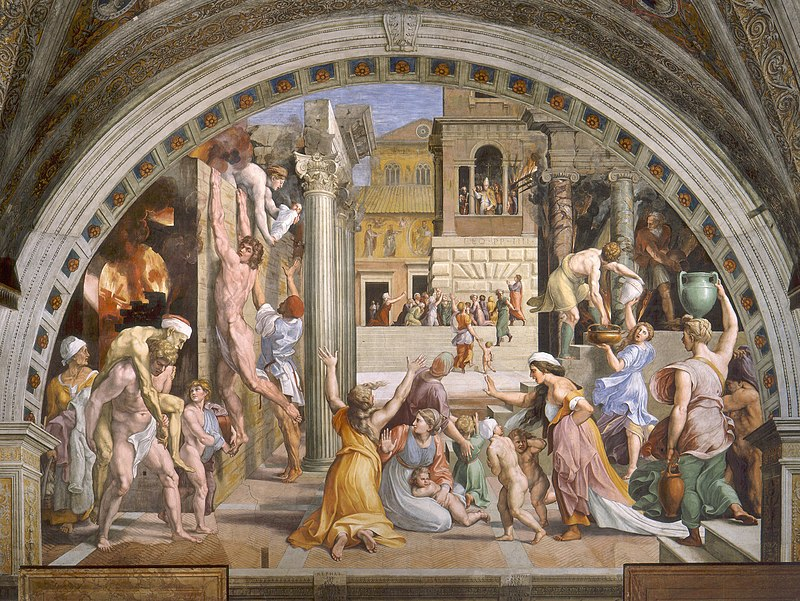
Raphael, Fire in the Borgo, Stanza dell’ Incendio, Vatican, (1510)
Commission: Pope Leo 10th, part of the Medici family
Subject: 20 ft up, fresco, history of the church in 9th century, fire in the square in front of old St. Peters where Leo 4th is believed to have done a miracle by simply gesturing a blessing towards the fire and putting it out
Form: rounded architecture, has his features, hyper detailed figures, Pope is far into the back, feels like a sidenote, faux marble columns, ionic capitals, incredibly detailed, fire in front far from Pope - not very logical in composition, all praising Leo for his actions, fear, attempts to put out fire, want help desperately (large contrast), bright colors, children are muscular too, intense bodily complex figures, strained poses, goes beyond grace and elegance, mannerism appears here: not sure what figures are meant to represent or what things are (lack of clarity) - directly against Renaissance ideals of the time, Greek figures in front represent Aeneas (part of founding group of Rome)
Function: attempt to promote Leo 10th by associating him with past popes named Leo

Raphael, Galatea, Villa Farnesia, Rome, (1510)
Commission: pleasure palace, Agostino Chigi, part of a larger scheme of mythological subjects in love
Subject: fresco, the story of Galatea and the giant who wanted to be married to her but she didn’t like him and ran away, also other figures in love/fighting love are around her
Form: draws upon literature and poetry in the context of art, decorative nature, aesthetic and bright, based off of the poem La Giostra by Poliziano (involved w/ Medici, fighting for the power of love), complex history and imagery, pose of Galatea, 3 cupid figures above aimed at Galaeta, sea horse + figure blowing a horn, no so much stability/balance, things are crazy, everything is intertwined, enticing, water is not realistic and acting as it should, hooves shouldn’t rest on water, feels frozen, glides across it, mannerism is very evident here!, not realistic but very elegant and beautiful, conscious awareness of the connections to Venus and Botticelli
Function: encourages pleasure seeking of wealthy people, shows that realism can be sacrificed for beauty
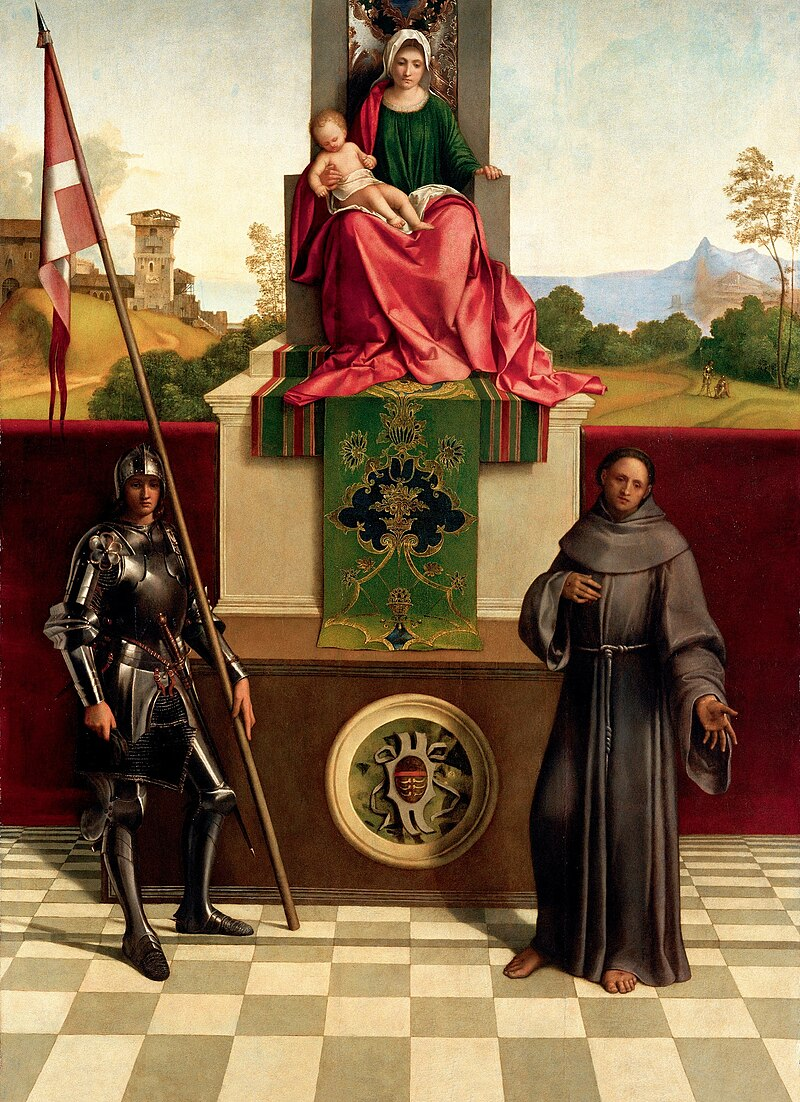
Giorgione, Enthroned Madonna with Saints Liberalis and Francis, (1505), Venice
Commission: Castelfranco Cathedral, Tuzio Costanzo (mercenary soldier), Liberalis is patron saint
Subject: oil on panel, altarpiece, 4 figures: Christ child, Mary, St. Francis, and St, Liberalis
Form: full sacred conversation, extensive background/significant landscape, intricate/delicate patterns in cloth, lots of inspo from Bellini, no more church architecture, red flag and white cross - given to military campaigns for Christ, coat of arms, tall throne completely separating us from Mary and Christ, Mary not wearing traditional colors besides pink, signs of war and destruction on the left above soldier, signs of nature on the right about St. Francis, two soldiers resting in background, suggestion that Mary and Christ are figures to appeal to during war and loss, melancholy mood,
Function: identifies Costanzo with the St. Liberalis and Christianity, commemorates his son (died in battle under father), represents that there are things worth protecting and the beauty of nature before war
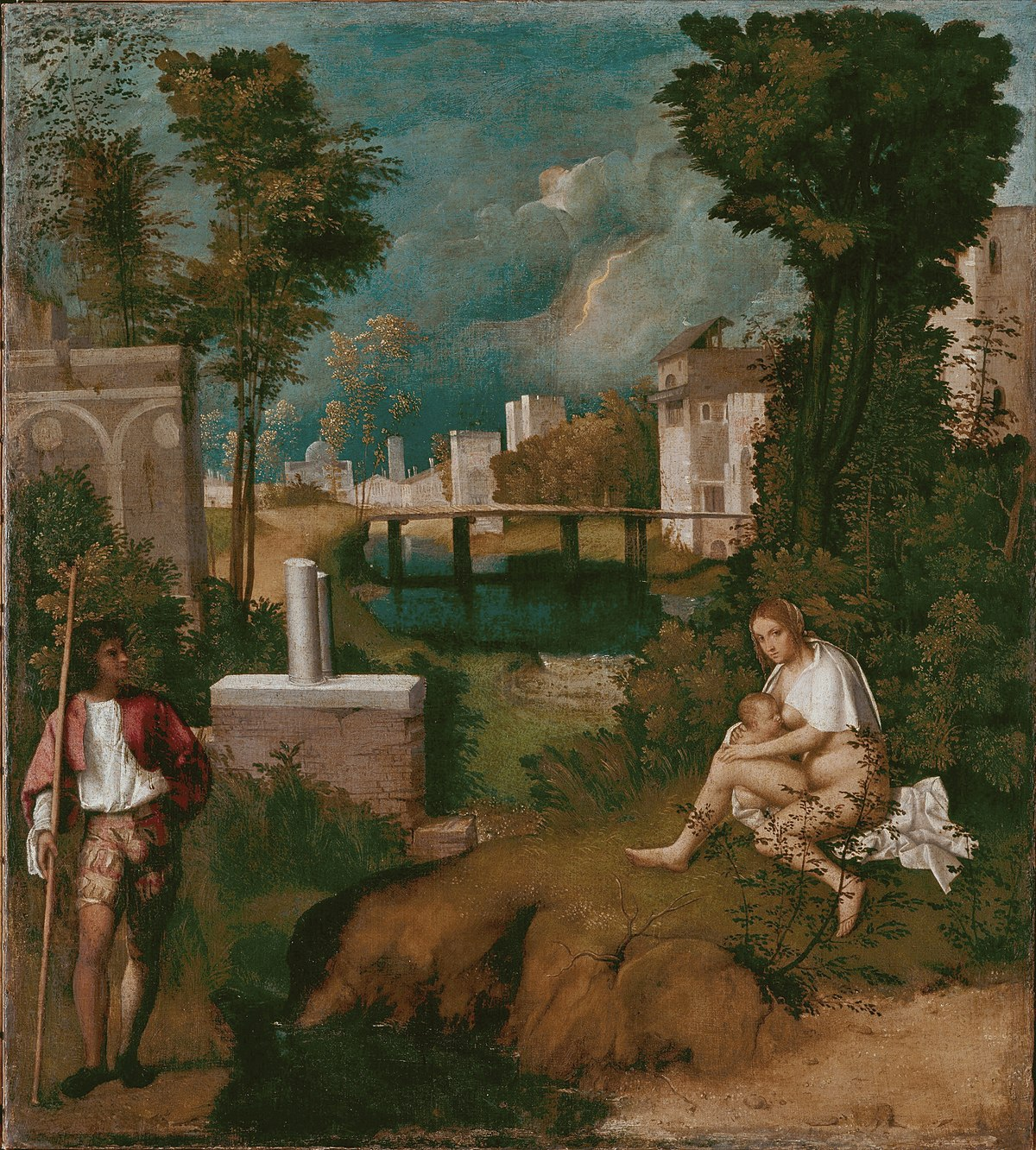
Giorgione, Tempest, (1505),
Commission: unknown
Subject: oil on canvas, a woman feeding her child and a German soldier are at the front of the painting while nature and a storm are the main focus, 32 inches by 28 inches
Form: not a logical narrative, figures have been forced to the side used as a framing device, storm in the sky= tempest, woman is seen as a traveler, comfortable in the world, not respectable, soldier looks like a German mercenary soldier, unkept nature to him, very original, naturalness of blending in with nature, plants envelop woman looking in our direction, weedy/shaggy nature, overgrown, architecture is falling apart, lightning flashes in the sky, clouds are intense, appears to have wind with trees, colors add to the lushness, awareness of how the lightning flashes off surroundings, details in tree are very light, uses the canvas in a new way
Function: Energy in nature, “landscape with figures and not figures with landscape,” it is the study of the forces of nature, figures are a sidenote, energy goes to the nature
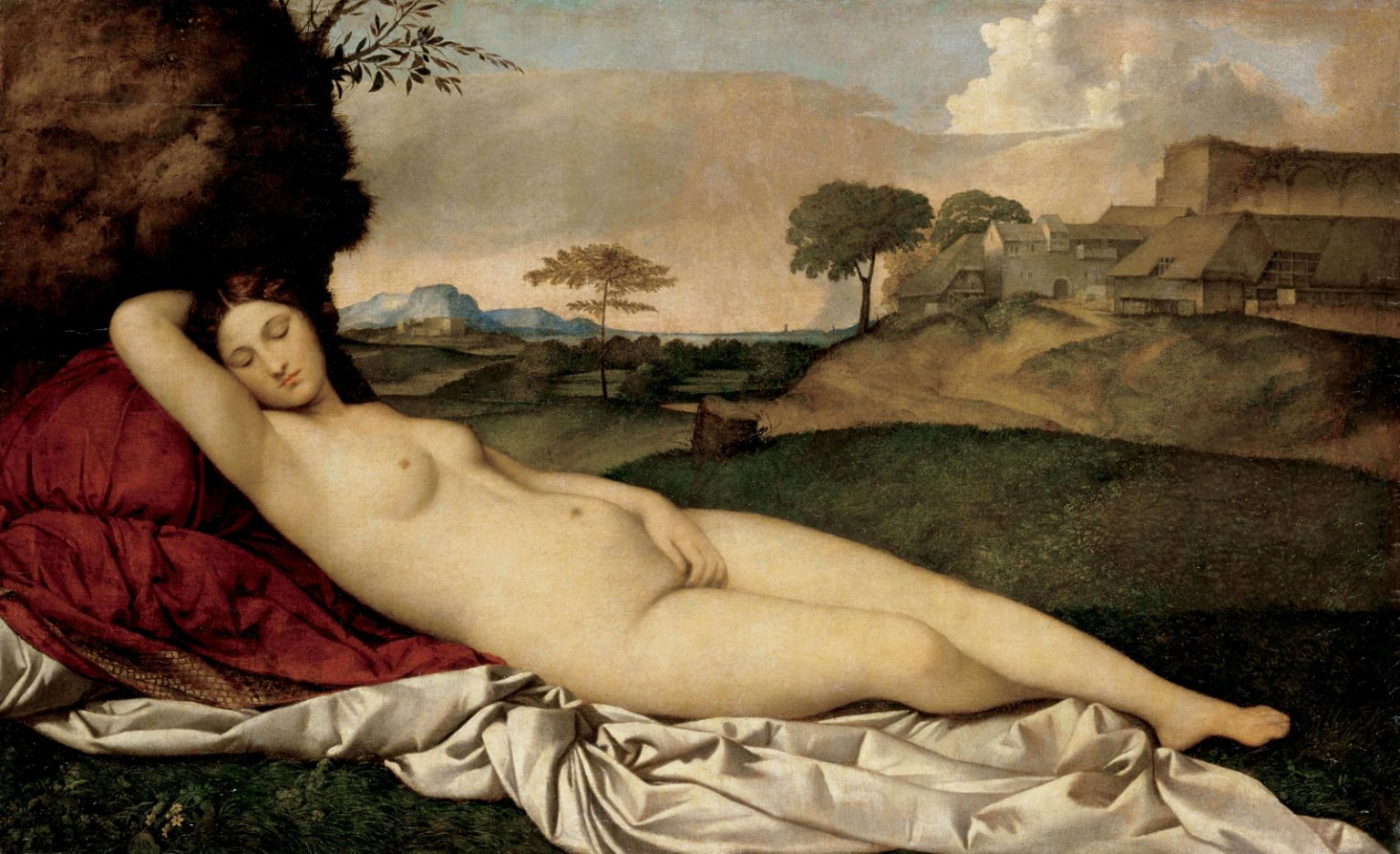
Giorgione, Sleeping Venus, (1505),
Commission: unknown
Subject: 3 ft by 5 ft, oil on canvas, sleeping Venus lounges in front of canvas, a part of the landscape (mirrored by hills)
Form: landscape has prominent role, red and white garments, pillows, blanket/sheet, sensual aspect, in the country, used to have Cupid holding a bird but was painted over, setting is not very classical, houses are distinct and not Italian (German), idealic landscape, classical subjects connect to the poetry/literature of today, Francesco Colonna’s The Dream of Poliphilus was where a man fell asleep in the country and dreamt of an imagined land where he can find his love, mythical fantasy realm, not a painting for the uninformed, could possibly been part of a chest/piece of furniture (dowry)
Function: first of its type, reclining nude figure, inspires many Venus types afterward, transformation of classical subject, emphasis on the role of fertility
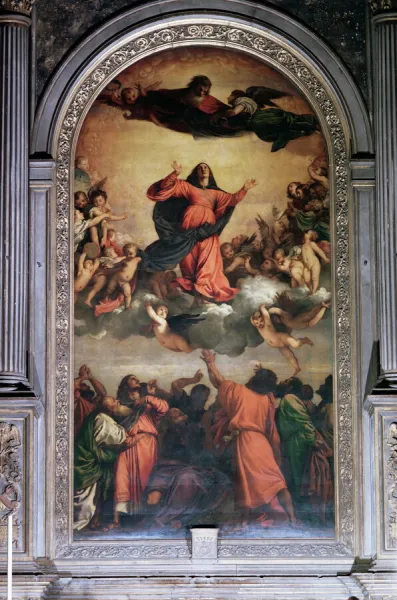
Titian, Assumption of the Virgin, Santa Maria Gloriosa dei Frari, Venice, (1520),
Commission: Abbott of the church commissioned it
Subject: HUGE! High altarpiece, 22 ft by 11 ft, oil on panel, 3 days after Mary’s death, she was carried to heaven by angels (parallel to Christ),
Form: very dramatic story telling, can’t pull away from it, verticality, appropriate for the subject, lifted upon clouds, angels are everywhere, pointing, music, celebrating, diagonals and energetic, Mary gazes up reverently at God, lot of angel heads in heaven, the apostles are dramatic and active in this celebration at the bottom, dramatic drawing us up, almost touching, can see the tomb, heroic and monumental figures, shape is a triangle, helps maintain order and clarity, color reinforces it (figures in red), continuity → not as just forces, but unifying
Function: show verticality in art, set a standard for monumental pieces of art, balance and order can be maintained even in chaotic pieces, color can be used to connect figures
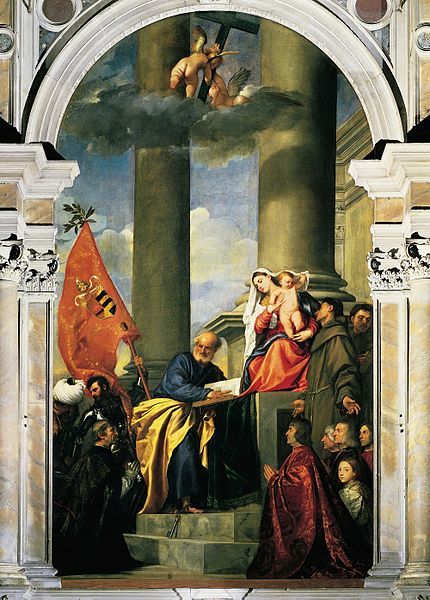
Titian, Pesaro Madonna, Santa Maria Gloriosa dei Frari, Venice, (1520),
Commission: Pesaro family (father included in painting), family chapel
Subject: side altarpiece, oil on canvas, large, Mary and Christ are in a sacred conversation with St. George, Francis, and Peter where the Turks, Pesaro father, and other family members are being presented
Form: thinks about location while painting, coming in from the side and not head on, offset his image to make continuous motion towards Mary and Child, dynamic composition that is angled and diagonal, massive columns that pull us upward to the heavens, cap at the top, elaborate frame connects with image, sacred conversation, Mary is focal point, bright colors saturated, Corinthian capitals, directly engaged figures, Pope Alexander V’s coat of arms, papal tiara - Peter is first Pope, little baby angels at the top with Christ’s cross, triangle still present.
Function: organization and order can exist with dramatic power, connects the Pope and family with ancient Christian figures.

Titian, Bacchus and Ariadne, (1520),
Commission: Duke of Ferrara (Alfonso d’ Este), placed in the Alabaster room of his palace opposite the room of wisdom and grace
Subject: oil on canvas, 5 ft by 6 ft, mythological scene focused on celebration and excess, Ariadne was left on an island by Theseus and as he sails away Bacchus immediately shows up and falls in love with her
Form: lot of blues, Catullus, Latin Poet (Roman), direct representation of parts of this story in painting, extensive landscape, groups of revelers behind him following, hybrid creatures and nymphs, chariot drawn by 2 cheetahs (court zoo was connected with this), Bacchus crowned with Greek vines, Bacchus leaps forth and startles her, Ariadne in the motion of waving to get ship’s attention, he promises her a crown of starts/ the sky which is referenced in the top of painting, figure of the Laocoon present, diagonal movement, coming in from the side w/ energy, lot of ultramarine blue, color is lush and enticing, details in drapery, young fawn carries a head and man is covered with writhing snakes
Function: provides a scene of celebration and excess for viewers, can see joy and revelry

Titian, Danae, (1550),
Commission: Philip II of Spain, King
Subject: oil on canvas, 4 ft by 5 ft, daughter of King of Argos had a prophecy that said her son would kill the king so he locked her away, Jupiter desired her and transformed himself into a golden shower to engage with Danae so she gives birth to Perseus
Form: transforms into golden coins which distract the older woman attendant, chain shows she is locked away and has no freedom, emphasis on the greedy maid service, no longer protecting Danae - classic image of love for sale (old woman offering up young woman for sale), rough appearance, age, materialistic, Danae is not afraid and doesn’t turn away, is receptive of this situation, openly sensual, Danae is turning away from her father, emerging style of very loose brush strokes with softness, inspiration from Michelangelo
Function: wanted to be illustrated like the loves of Jupiter to be a celebration of self, views himself as a “god”, conquest of mortals (dominating power)

Titian, Rape of Europa, (1565),
Commission: King Philip II of Spain, part of the conquests of Jupiter
Subject: Zeus turns into a bull and kidnaps Europa who was playing by water when Zeus shows up as a bull and she becomes mesmerized by its beauty and rides it, then the bull starts to run away so she had to go with it.
Form: beautifully enticing w/ paint application, aesthetically pleasing colors, softness of shades, blues of water, greens, reds, pinks, creaminess of Skin, thick, heavy impasto as the bull leaves the water, angels are desperately trying to shoot her so she will be calmer and more in love, can see the fear on her face, attendants are panicked and gesturing in a scared matter, Titian diagonal, wedge form, very dynamic and dramatic, charged brushwork, nontraditional approach, normally sedated and decorative, captures fear and surprise, doesn’t want to fall in but doesn’t want to go with the bull, skin has so much color, mountainous background, reflections in the water
Function: suggests parallels between King and Jupiter, origin of Europe and the Minoans of Crete

Titian, Pieta, (1570),
Commission: commissioned by Titian for his burial tomb at Santa Maria Gloriosa dei Frari, Venice
Subject: 11ft by 12 ft, Mary is holding her son and is surrounded by figures
Form: centrally placed in architecture, art is very introspective, unusual treatment, Titian directly interacts with Christ, woman is reaching out and engaging - Mary Magdalene, little cherub holding a jar, solid structure, semi circular dome, byzantine element since he is Venetian, loose brush strokes as you get close, pelican piercing its brest to feed its young painted up top to show Christ’s sacrifice through blood, angel holding a torch, symbol of resurrection, sculpted figures → Moses and Roman sybil who holds a cross and has a crown of thorns (predicted crucifixion), halo of Jesus and subdued colors, small painting off to the side leaning against lion, coat of arms of Titian, rep of heavenly Pieta with Titian and son
Function: wants to meditate on Christ’s sacrifice, shows it in a different way to show realism, Jesus is considered the law of Moses so He fulfills all old Law, asks for deliverance from fear and suffering → plague

Agnolo Bronzino, Allegory with Venus and Cupid, (1540),
Commission: Cosimo I, gift to King of France who liked erotic pieces of art
Subject: allegory of lust, oil on panel, large, Venus and Cupid are touching each other while Time and Oblivion try to cover up the scene, other figures show aspects of lust
Form: overcrowding, odd things happening, bodies behaving in strange ways, inappropriate actions and behavior, unpleasant consequences, strange and unnerving (point of mannerism), dove is part of iconography, speaks to unchaste love, Venus holds golden apple, crowned, and holds cupid’s arrow, figure of time above them, elements of kingship are here!, scepter and orb show kingly power and god-like status, Oblivion is trying to draw a curtain over the scene while Time tries to help/stop, boy about to throw flowers - represents foolish pleasure, also about to step on a thorn (unaware of consequences), figure behind is freaky, hands and body not realistic, holding on to a honey comb while also having a thorn in hand - Deceit, masks down below represent deception, figure on the left is fully suffering consequences - rep of Pain, Syphilis - French Disease
Function: captures artificiality of mannerist works, puzzle offered to Francis to figure out the message
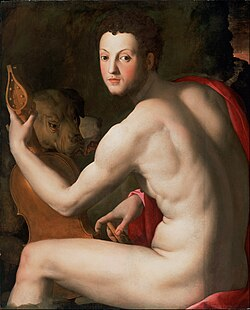
Agnolo Bronzino, Portrait of Cosimo I de Medici as Orpheus, (1540),
Commission: Cosimo I de Medici, Grand Duke of Tuscany
Subject: Orpheus and is a very good flute player and went to the underworld to save his wife but doesn’t succeed b/c he looks back to her,
Form: very nontraditional portrait, Ovid inspired this painting, underworld is evident in the background (reds and blacks), Cerberus next to Orpheus (aka Cosimo I), holding a very realistic flute that can distract Cerberus and convinces Hades to free Eurydice, mannerist style: body is not proportional, head cannot turn as far as it does, tiny, ideal figure, made to look very young and pretty, porcelain skin and exaggerated curls in the hair, not enough space in the picture for everything going on, downward movement, highly muscular body type, inspired by Belvedere torso
Function: story of a man who loves his wife → message for Cosimo I’s wife Eleanor de Toledo
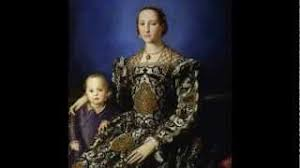
Agnolo Bronzino, Portrait of Eleonora of Toledo with her son Giovanni, (1540),
Commission: Cosimo I,
Subject: Cosimo I’s wife and son
Form: idealized pattern, creepy porcelain skin, dead stare, hand is very elongated, grace, elegance, status, formality, aloofness in face, decorative patterns and jewelry, blue ultramarine background, upright positioning, shows her status, real gold sprinkled in showing precious aspect of son, emphasis on plump and healthy, Madonna and child quality, monumental presence, lightness of color around her head gives her a divine presence, Spanish textiles are reflected in the decorative patterns of her dress
Function: shows the elegance and wealth of his wife and son and also shows the personality of his wife.
Confraternity of the Immaculate Conception
Group that focused on the public veneration of the Blessed Virgin Mary
Ludovico Sforza ( Duke of Milan)
Considered enlightened, generous, and peaceful, he became a patron of artists and writers. His court in Milan became one of the most important in Europe during the Italian Renaissance. Somewhat contrarily, Ludovico was also considered fearful and of a fickle nature.
Francesco del Giacondo
Italian nobleman and merchant. According to Giorgio Vasari, del Giocondo would have commissioned Leonardo da Vinci's La Gioconda; in fact, this portrait could be of his wife, Lisa Gherardini.
Pope Julius II
Significant role player in the Italian Renaissance, both as a patron of the arts and for his ambitious political and military endeavors, including expanding the Papal States and commissioning masterpieces like the Sistine Chapel ceiling
Pope Leo X (Giovanni de Medici)
A prominent Renaissance pope and son of Lorenzo the Magnificent, is best known for his extravagant lifestyle, patronage of the arts, and his role in the early stages of the Protestant Reformation, including his excommunication of Martin Luther.
Pope Alexander VI
Known for the rampant corruption in his papacy. His lavish lifestyle, his mistresses, his many children, and his blatant nepotism, granting land and positions to his relatives, are what he is remembered for today.
Angelo Doni and Maddalena Strozzi
Agnolo Doni (1474-1539) was a wealthy Florentine fabric merchant and art collector, and Maddalena Strozzi (1489-1540) was his wife, a noblewoman from a prominent Florentine family, who married on January 31, 1504.
Agostino Chigi
Italian banker and patron of the Renaissance. Born in Siena, he was the son of the prominent banker Mariano Chigi, a member of the ancient and illustrious Chigi family. He moved to Rome around 1487, collaborating with his father.
Poliziano, La Giostra (1475-1478)
a narrative poem celebrating the 1475 Florentine tournament and the victory of Giuliano de' Medici, Lorenzo's brother, and his devotion to Simonetta Cattaneo, in whose honor he fought
Tuzio Costanzo
Italian military leader (condottiero) who commissioned the "Castelfranco Madonna" altarpiece by Giorgione, a painting now located in the Cathedral of Castelfranco Veneto, in memory of his son Matteo
Francesco Colonna, The Dream of Poliphilus (1499)
is a book said to be by Francesco Colonna. It is a famous example of an incunable. It is a mysterious arcane allegory in which the main protagonist, Poliphilo, pursues his love, Polia, through a dreamlike landscape. In the end, he is reconciled with her by the "Fountain of Venus".
Alfonso d’Este (Duke of Ferrara)
Duke of Ferrara from 1505, a noted Renaissance prince of the House of Este, an engineer and patron of the arts. Alfonso succeeded to the duchy at the death of his father, Ercole I.
Philip II of Spain
Ruler of one of the largest empires the world had ever seen. During his long life, he attempted to expand the power of Spain, centralize the government, and protect the Catholic Church against Protestant reformers.
Cosimo I de Medici, Second Duke of Florence (1537) and 1st Grand Duke of Tuscany
second and last duke of Florence from 1537 until 1569, when he became the first grand duke of Tuscany, a title he held until his death. Cosimo I succeeded his cousin to the duchy.
Sfumato
An Italian Renaissance art technique, meaning "gone up in smoke" or "faded away," characterized by soft, hazy transitions between colors and tones, creating a blurred, dreamy effect, most famously associated with Leonardo da Vinci.
Chiaroscuro
the treatment of light and shade in drawing and painting, an effect of contrasted light and shadow created by light falling unevenly or from a particular direction on something.